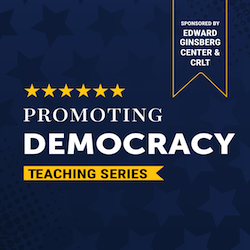
*updated November 7, 2018
During U-M's Veterans Week, it's a good time to reflect on the needs of our students who have served in the military. Did you know that record numbers of veterans are enrolling in U.S. colleges and universities--and many of them are here on U-M's campuses? Since January 2014, the university's tuition policy has allowed students who have served in the military to qualify for in-state tuition. If you teach at U-M, odds are good you've had or will have student veterans in your classroom.
How might your awareness of veterans in the classroom make a difference in your teaching? The research on student veterans suggests several strategies and cautions for teaching inclusively with veterans in mind. Here are a few:
Understand that veterans are diverse in their identities and viewpoints: As Alison Lighthall emphasizes in "Ten Things You Should Know About Today's Student Veteran," veterans vary widely in terms of their race, gender, ethnicity, sexual orientation, and political persuasion. She proposes ways instructors can connect with student veterans as individuals in order to support their transition to life in a civilian setting. These include respectfully accommodating any disabilities they have, as well as deliberately planning any class discussions about recent military engagements to include a full range of student perspectives. These CRLT guidelines for discussing controversial issues offer concrete strategies for facilitating conversations that productively engage diverse students. Additional ideas specifically about discussing war in settings with veteran and non-veteran students can be found in Chapter 4 of this National Organization on Disability publication on "Preparing Your Classrooms to Welcome Returning Veterans and Service Members."
Recognize that veterans' experiences do make a difference: Though veterans are a diverse group, they are generally older than most of their fellow students, and they bring life experiences that can cause them to feel disconnected from non-veteran students (this Michigan Daily article features some veterans talking about such challenges in transitioning to campus life). Instructors sometimes inadvertently exacerbate veteran students' sense of isolation by communicating assumptions about student backgrounds that exclude or marginalize them. These might include talking to students in ways that assume they all started college directly out of high school, that they're financially dependent upon their parents, or that their professional life in the "real world" is entirely in the future. Of course, examining your assumptions and teaching inclusively are good practice whether you know you have veterans in your classroom or not. Simply reminding yourself that some "invisible" veterans may be sitting in your class can help you create an environment where all students feel included.
Be deliberate about what you ask students to disclose in assignments: For instance, a 2013 white paper on "Promising Practices for Student Veterans in College Writing Classrooms" explains that reflective writing exercises, widely-utilized in college classrooms, can unintentionally invite disclosure by students who do not wish to have their veteran status known. Such assignments may also implicitly push students to describe traumatic events, which can be difficult for both student and instructor. Teachers can avoid these pitfalls by offering a range of options for such assignments, including examples of topics that help students avoid recounting recent experiences. Instructors should also communicate the specific learning goals and grading criteria of writing assignments so that students can make well-informed choices about what to write about and why.
Know your campus resources: U-M students and teachers can learn more about campus resources for veterans at the Veterans and Military Services website, which can be found at the memorable address of vets.umich.edu. As always, CRLT consultants are also available to any U-M instructor interested in consulting about ways to make their classrooms inclusive environments for all learners.
Editor’s Note: This blog, originally published in Nov. 2015, has been updated to provide up-to-date, accurate information.
Photo Credit: scrambldmeggs via Compfight cc
- Log in to post comments
- 274 views






